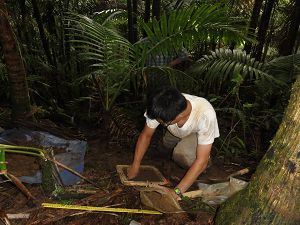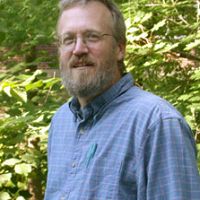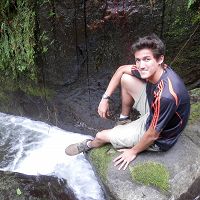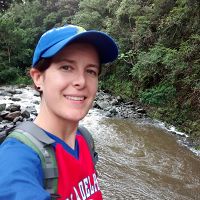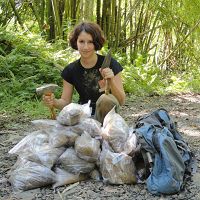Biogeochemistry Research Group
Biogeochemical studies in the Luquillo CZO are closely linked to all aspects of the CZO and are designed to increase our understanding of the role of lithology and weathering in the maintaining the biogeochemical processes of the earth surface.
Image: Xing Hao digging a soil pit in the Luquillo Mountains June 2010. Photo: Miguel Leon (University of Pennsylvania)
This group is tagged with:
-
Macronutrients, Soil Organic Matter (SOM), Atmospheric Inputs and Landuse
Previous work on the Luquillo surface soils has shown that: (1) pools of plant available macronutrients (Ca, Mg, K, and P) are much larger in the upper horizons (< 60 cm) than they are at depth (Zarin & Johnson 1995a); (2) soil nutrient pools are strongly dependent on SOM (Zarin & Johnson 1995b); (3) atmospheric inputs of macronutrients are substantial and nutritionally important to forest re-growth (Zarin 1995b, Frizano etal. 2002); and (4) macronutrient pools differ by landscape position, vegetation, season and land use (Silver etal.1994, Scatena etal. 1995, Cox etal. 2002). The gross stocks of SOM have also been quantified in forests and landslides (Silver etal. 1994, Scatena etal. 1995, Zarin etal 1995ab, McGroddy etal 2000). Unfortunately, most of these studies were focused on shallow surface soils in the VC. The physical and chemical quality of SOM has not been fully assessed in areas underlain by either lithology and SOM and nutrient stocks at depths greater than 0.5 m are virtually unknown. Nevertheless, studies elsewhere suggest that bedrock lithology can significantly modify SOM stabilization and storage, including studies on Hawaiian basalts and Sierra Nevadan granites, basalts and andesites (Torn etal. 1997, Rasmussen etal. 2005; 2006). Soil architecture, mineralogy, and chemistry also influence SOM incorporation into the subsurface (Mayer, 1994, Baldock and Skjemstad, 2000, Mikutta etal. 2006) such that we hypothesize that SOM incorporation in the GD soils will be dominated by physical occlusion while SOM stabilization in VC soils will be dominated by sorption on reactive mineral surfaces. These differences are expected to influence the depth of weathering (H2), riparian processes (H5) and the fate of atmospheric inputs (H7). To address these basic questions the LCZO is quantifying soil nutrients and stream exports by lithology, hillslope position, and forest type. Process based experiments are also underway to quantify the role of microbial communities and soil oxygen on nutrient availability. Available infrastructure include monitored watersheds, long-term vegetation plots, and legacy information on vegetation nutrient use.
For additional information regarding ongoing Biogeochemical research please see LCZO data website.
-
Contacts
-
Luquillo, INVESTIGATOR
22 People
INVESTIGATOR
Low-temperature aqueous geochemistry and biogeochemistry with a focus on modern terrestrial systems
.(JavaScript must be enabled to view this email address)
Biogeochemistry, weathering
GRAD STUDENT
.(JavaScript must be enabled to view this email address)
Carbon cycling
INVESTIGATOR
.(JavaScript must be enabled to view this email address)
Soil Ecology
GRAD STUDENT
.(JavaScript must be enabled to view this email address)
---
Cross-CZO INVESTIGATOR, PostDoc
.(JavaScript must be enabled to view this email address)
Geology, Geochemistry, Isotope Geochemistry
GRAD STUDENT
.(JavaScript must be enabled to view this email address)
Isotopic and trace element geochemistry
INVESTIGATOR, Lead-PI
.(JavaScript must be enabled to view this email address)
biogeochemistry, Hydrology
GRAD STUDENT
.(JavaScript must be enabled to view this email address)
Trace-metal interactions at mineral surfaces
INVESTIGATOR
.(JavaScript must be enabled to view this email address)
Isotopic and trace element geochemistry
Cross-CZO INVESTIGATOR, COLLABORATOR
.(JavaScript must be enabled to view this email address)
Penn
Biogeochemistry
INVESTIGATOR
.(JavaScript must be enabled to view this email address)
Mercury and Carbon Biogeochemistry
INVESTIGATOR
.(JavaScript must be enabled to view this email address)
Soil Trace Gases
INVESTIGATOR
.(JavaScript must be enabled to view this email address)
---
Cross-CZO INVESTIGATOR, COLLABORATOR
.(JavaScript must be enabled to view this email address)
UGA
Soil biogeochemistry
GRAD STUDENT
.(JavaScript must be enabled to view this email address)
Nutrient Cycling
INVESTIGATOR, PostDoc
.(JavaScript must be enabled to view this email address)
Stream Ecology, Stream biogeochemistry
Alumni-Former
Cross-CZO GRAD STUDENT
.(JavaScript must be enabled to view this email address)
UGA
Soil Chemistry
.(JavaScript must be enabled to view this email address)
River Biogeochemistry
INVESTIGATOR
.(JavaScript must be enabled to view this email address)
Soil Science
.(JavaScript must be enabled to view this email address)
Field Technician, Biogeochemistry
GRAD STUDENT
Interactions between soil microbes and soil organic matter
-
-
Featured Publications
1993
Biomass and Nutrient Content of the Bisley Experimental Watersheds, Luquillo Experimental Forest, Puerto Rico, Before and After Hurricane Hugo. Scatena, F.N.; Silver, W.; Siccama, T.; Johnson, A., and Sánchez, M.J. (1993): Biotropica
1999
A nitrogen budget for late-successional hill slope tabonuco forest, Puerto Rico. Chestnut, T.J., D.J. Zarin, W.H. McDowell and M. Keller (1999): Biogeochemistry
1999
Soil oxygen availability and biogeochemistry along rainfall and topographic gradients in upland wet tropical forest soils. Silver, W.L., A.E. Lugo and M. Keller (1999): Biogeochemistry
2010
phosphorus cycling in deep saprolite, Luquillo Mountains, Puerto Rico. Buss H.L., Mathur R., White A.F., and Brantley S.L. (2010): Chemical Geology
2000
Effects of hurricane disturbance on stream water concentrations and fluxes in eight tropical forest watersheds of the Luquillo Experimental Forest, Puerto Rico. Schaefer, D.A.; McDowell, W.H.; Scatena, F.N., and Asbury, C.E. (2000): Journal of Tropical Ecology
2000
Variation in below ground carbon storage and soil CO2 flux rates along a wet tropical climate gradient. McGroddy, M., and C. E. Ashbury (2000): Chem. Geol.
2006
Redox fluctuations in a humid tropical forest soil impact N-cycling rates by framing the composition of the soil microbial community. Pett-Ridge, J., W. L. Silver, and M. K. Firestone (2006): Biogeochemistry
Explore Further
